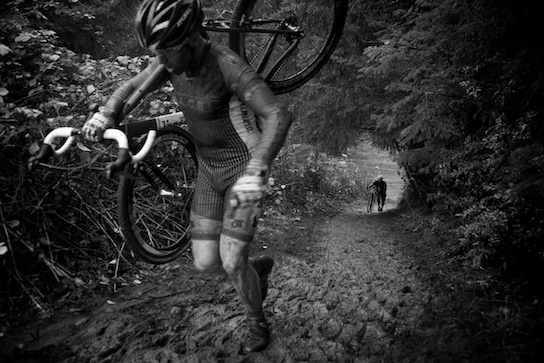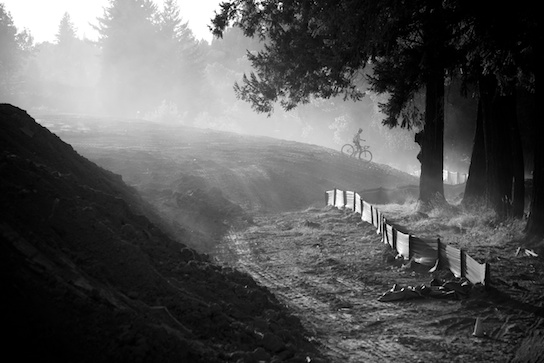 Sometimes a moment happens so quickly you can only hope that you get it. Even in those cases, knowing where the moments are likely to happen increases the likelihood of capturing them in a way that reflects a unique quality. I was trying to show how difficult this day's race was and how supportive riders can be of each other, which drove decisions of how to compose this setting in the five frames I made. It succeeds to the degree I'm capable. © Mike Davis
Sometimes a moment happens so quickly you can only hope that you get it. Even in those cases, knowing where the moments are likely to happen increases the likelihood of capturing them in a way that reflects a unique quality. I was trying to show how difficult this day's race was and how supportive riders can be of each other, which drove decisions of how to compose this setting in the five frames I made. It succeeds to the degree I'm capable. © Mike Davis
This question came up in a conversation after the National Geographic Seminar a few weeks ago: How do you know when you’re done making a picture in a given setting?
The friend who posed the question said she had asked the question of a mutual friend, who asked in return: How do you know when you’re done going to the bathroom?
I paused hearing this, as many of you may have. It’s a shrewd response. Because you can always leave a scene wondering if you could have done more. Or you can linger indefinitely, thinking that more might happen.
No doubt everyone regularly has that dreaded feeling of missing a moment, of watching a fleeting instant pass by without having pushed the shutter release, or you’ve experienced a coming together of a unique composition that your brain enjoyed but failed to inform your finger poised at the shutter release. That’s a part of the quotient, for sure. We either get the moment or we don’t.
Here’s a further perspective, derived from having looked at the work of hundreds, if not thousands, of photographers. I love looking at the whole takes of photographers and I prefer to look at whole takes. Seeing every frame reveals a lot, including whether photographers get the best picture from a given setting.
Photographers tend to make pictures in settings in one of three ways, or combinations/variations of these three:
1. You capture the rhythm of settings by making five frames: it’s not happening, it’s starting to happen, it peaks, it begins to subside, it’s over. (Multiply the actual number of frames you make by a factor of how much you rely on the motor drive to make the picture.)
2. Then there is the rhythm that wanders, seemingly aimlessly, trying to find the picture frame after frame, by exploring a setting or whatever is happening. Sometimes the magic happens, sometimes it doesn’t. The less clear you are in what you’re after, the less likely you’ll succeed with this approach. You may not even recognize a picture that does have magic if you have no clue of what you were trying to capture. Letting your informed mind and eye respond to a setting without a filter can be magical. These pictures will tend to be reflections of the essence of the person who made them; they will reach as deep and wide as the person can reach - and occasionally something beyond your self will happen. When that happens, the trick is recognizing the image that breaks ground.
3. Then there’s the single frame grab, when you just make one or two pictures as a response to something your mind or eye saw. These pictures can occasionally be hugely successful but many photographers pass them by because the effort to make the picture was minimal. (The opposite of this is when photographers prize an image because of the extreme effort it took to make the frame or what happened was a great experience - even if it’s not that great a photograph.)
With each of the three approaches, the more clear you are in what you set out to do, the more likely you’ll know whether you made the best photograph you could from what was there. And by extension, the more you set out to convey with the photograph, the greater the experience for people who look at the image. But you also have to stay open to surprises, to types of images that you didn’t necessarily set out to make but that have the magic.
The less you set out to do, the more likely you’ll feel confident that you succeeded. If you simply want to show the facts of what happened, then chimping will show you that you got it. If you want to show what it felt like for the subject to execute or achieve what happened, it’s more difficult to know whether the image conveys all it could.
There are approaches to making pictures that increase the chances of making the best picture possible in a given setting. Though it’ll still be inevitable that we miss the magic some of the time. In this sense, photography is like a sport. We can’t always score but we can lay out the best game plan possible.
 In this case, I wanted to convey the challenge of climbing this hill. I saw the two pools of light, created a composition that had depth and waited for riders to fall in place. It took a while but finally things fell in place. © Mike Davis
In this case, I wanted to convey the challenge of climbing this hill. I saw the two pools of light, created a composition that had depth and waited for riders to fall in place. It took a while but finally things fell in place. © Mike Davis
Virtually every situation has an ebb and flow. Things begin to happen, they peak and then subside - #2 above. The more moment-driven situations tend be more like this than ones you’re creating but even controlled settings will have a natural rise and fall.
So in these settings, it’s ideal to be aware of when and where the rise is likely to happen, to be the right distance from the subject with a composition that conveys the quality you want to convey and seeing the light and color in a way that further reflects an essence.
Having a crystal ball helps. But the critical thing is having some sense of what you want to say with the picture - more than just capturing the facts of the scene. That will drive all other decisions and will clue your mind and your eye into things you wouldn’t even be aware of if all you were doing is showing what happened.
It’s important to understand as much as you can about whatever you’re photographing. Of course. But it’s equally important to listen to your own reactions to and impressions of a scene, whether it’s active or scenic, a wide view or a detail, controlled or not.
Letting yourself be free to explore the scene or subject from an informed perspective is the goal. Making magic is the hoped-for result. And who knows if it will happen, until you know.
 In this setting, the backlit dust caught my attention and I kept an eye on the setting, hoping that something would happen to introduce a moment that reflected the time and space. I made three frames and one got the rider in the right spot.© Mike Davis
In this setting, the backlit dust caught my attention and I kept an eye on the setting, hoping that something would happen to introduce a moment that reflected the time and space. I made three frames and one got the rider in the right spot.© Mike Davis
